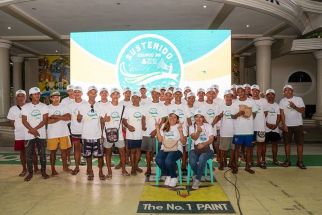A taste for rebellion
We started breakfast with a revolution, spent the afternoon haunted by the cries of a woman looking for her deceased husband and watched the sun set from the comfort of a sniper’s watchtower.
Not a bad way to spend a day in Cavite.
Especially when in the company of food writer, book designer and proud Caviteno Ige Ramos, who treated a bunch of ADHD millennials and nakiki-millennials to a culture, food and history tour on steroids. We visited so many cultural touchpoints in one day that it taxed our ability to flat-lay our Instagram posts properly. (If you don’t get what I mean, Mag-Salonpas ka na.)
And you knew in your clickbait-addled mind that this tour was going to be YOLO when our first stop was to visit the descendant of the first person to kill a Guardia Sibil back in the pre-Facebook year of 1896. Ige — a member of the Culinary Historians of the Philippines — took us to Malen’s Restaurant in Noveleta, run by a great-great-great-grandson of Gen. Pascual Alvarez, a brigadier general of Emilio Aguinaldo, one of d’original “Agaw Armas” insurgents and a member of the Magdiwang faction of the Katipunan who forcibly took the arms of the Spanish Guardia Sibil.
We ate a Magdiwang breakfast inspired by what rebels were probably served during those times: treasonous tinapa from Salinas, insubordinate Imus longganisa, seditious omelet with burong mustasa and wayward ensalada, washed down with recalcitrant tablea hot chocolate (Ige’s insider advice: Masmasarap ang lalaking galunggong. It’s got, er, those tastier bits).
After breakfast, I connected with a bit of my family history while I was in the little rebels’ room. Serendipitously hanging over my urinal was an oldtimey picture of a ship lying beside a sign that read “Gen. Ledesma Slipway (Erected 1874).” (Ledesmas are known for their longevity.) This piqued my interest since Ledesmas hail from the Visayas. Ige — who was rebelling in the neighboring urinal — explained that shipyards were an integral part of the province’s commercial history during the Spanish galleon trade. When the Americans took over, they continued to use the dry dock for commercial shipping. After World War II, the ownership was transferred to private entities like the Ledesmas from Iloilo or Bacolod. However, Ige was unsure if our ship was still erect.
Because of all the talk of longevity and erectness in the urinal, Ige thought it best that we make our way that noontime to the Immaculate Concepcion in Naic, Cavite for appropriate punishment. After praying several thousand Hail Marys, Ige treated us to sublime local delicacies that were born from Cavite’s historical “crops of oppression” — sugar, rice and coconut. These include muche (rice flour with sweet munggo filling) and alikaya (black glutinous rice called pirurutong with latik). But the real kakanin that made the flogging worth it was the sinudsod (ground rice flour and leftover rice cooked like a pancake, after which it is placed in a bowl filled with gata, buko juice, buko strips, sugar and gulaman).
Once the forklift loaded us back on the tour bus, we proceeded to the most arresting part of the tour: the Museo Ng Paglilitis Ni Andres Bonifacio (Museum of the Trial of Andres Bonifacio) in Maragondon. Erected in 1889 by its owner Teodorico Reyes, this private residence is where the infamous two-day-long “sham trial” of the Katipunan founder together with his brother Procopio was held in May 1897.
But the emotional gut punch of the tour was the gallery of Gregoria “Aling Oriang” de Jesus, the wife of Bonifacio and founder of the women’s chapter of the Katipunan. After being released from detention on May 8, 1897, she embarked on a tireless month-long search to find her husband, literally scaling mountains and questioning soldiers (who gave her the runaround) as to the whereabouts of Andres. Finally, Oriang learned that her search was in vain. Her uncle Gen. Mariano Alvarez (the brother of Pascual) broke the news that Andres had already been executed by the order of the War Council on May 10, 1897 at Mt. Buntis, Maragondon.
Oriang’s timeless longing to be reunited with her husband continues to haunt us in her poem that was so heart-wrenchingly interpreted in song by Aiza Seguerra:
Paalam sa iyo, masarap magmahal,
May-ari ng puso ko’t kabiyak na katawan;
Paalam, giliw ko, sa iyo’y paalam.
Masayang sa iyo’y aking isasangla
Ang sulam pamahid sa mata ng luha,
Kung kapusin palad, buhay mawalla,
Bankgay man ako, haharap sa iyong kusa.
Reliving the sham trial left a bitter taste in our mouths. So Ige took us for a restorative lunch at Calle Real — a mercantile-class ancestral home converted into a restaurant in Tanza, Cavite that serves Caviteno fare with a distinctive oomph. We savored dried pusit salad in tamarind dressing, tokwa sisig, burong manga, paella negra, crunchy pork binagoongan and the heritage dishes calandracas (derived from calandra or patungan ng ataul, it’s a noodle dish once served exclusively during wakes) and sopas tanza (a local wood-fired oven-baked biscuit from the 96-year-old Kaibigan Bakery).
After savoring our freshly brewed Amadeo coffee, Ige whisked us off to our final stop. The Aguinaldo Shrine in Kawit was the site of many historical firsts: the first time the Acta De La Proclamacion De La Independencia was unrepentantly read from the center window of the house; the first time the Philippine flag was fiercely unfurled; and the first time the Marcha Nacional Fiipina (now the Philippine National Anthem) was uproariously played.
Though I have to admit that coming over to the Aguinaldo Shrine from the Bonifacio Trial Court Museum (coupled with my impression of Aguinaldo from watching Heneral Luna) left me feeling conflicted over the First President of the Republic. However, as we explored the galleries with our tour guide, I learned to appreciate this controversial figure. This former ancestral home told the story of a man who was a product of his time — a revolutionary, a military man, a politician. And his life story informed me that there are times that we are called to do greater things despite ourselves.
As we squeezed into the cozy sniper’s tower to take in the panoramic view of Cavite by sunset, we were about to dig into Baloy’s hand-kneaded ensaimada de Cavite and Pat & Sam’s homemade bibingka Malagkit. Unfortunately, Ige and I were ushered out of the shrine when the caretakers discovered that we had made a detour during the tour into the house’s underground bomb shelter tunnel in search of gold (kasi sabi nila, National Treasure ang Aguinaldo Shrine).
Salamat, Cavite. It was an exhausting day that left me with a lot of food for thought. And about three more inches around the waist.
* * *
Join the next Cavite Food Tour on Aug. 6. For more information, email EatYourHistory@FoodHolidays.ph.
















